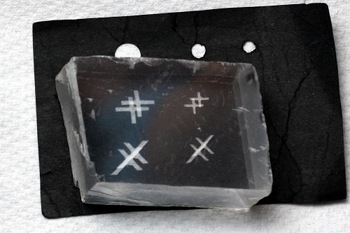What it shows:
A birefringent substance will split unpolarized light into two polarized rays with different refractive indices and different velocities. A crystal of calcite demonstrates this phenomenon.


How it works:
The optic axis of a crystal is defined by the symmetry of the lattice. In calcite CaCO3, the CO3 forms a triangular cluster, and the optic axis is perpendicular to this. If light enters along the optic axis, nothing dramatic happens and the light emerges unpolarized. If however the light enters at an angle to this axis, the asymmetry of the lattice splits the ray into two with mutually perpendicular polarizations (figure 1). One ray is called the Ordinary ray, for which Snell's law holds. The other Extraordinary ray does not obey Snell's law.
figure 1. Birefringence in a calcite crystal
Observing an object through the crystal, one sees a double image. Analysis through a Polaroid sheet shows that these images have axes of polarization at right angles to each other; rotating the Polaroid makes the images alternately vanish. Things get really exciting when you place a second crystal on top of the first. Now you have fours images, but if you rotate it, it acts as an analyzer for the first crystal, and you can go down to two images again.
Setting it up:
We have two calcite crystals; one a nice 5×3×3cm, and the other slightly smaller, which you can sit on piece of black card with little circular and cross shaped holes cut in it. Place this on an OHP or document camera.
Comments:
Calcite usually occurs in an impure polycrystalline form as marble, limestone, or chalk. Optical calcite, or Iceland spar, is quite rare. Before the 20th century it came almost entirely from a cavity in basalt 11 by 4.6 m2 in area and about 3 m deep, located by the farm Helgustadir near Reydar Fjördur on the east coast of Iceland. When first found, the cavity was filled with a pure crystallized mass containing enormous crystals, some a yard across. This source is now exhausted, but crystals from it described in detail by Erasmus Bartholinus in 1669, led to the discovery of the polarization of light by Malus in 1808. Optical calcite now comes principally from Mexico, Africa, and Siberia. (from Handbook of Optics sponsored by the Optical Society of America (McGrawy-Hill, 1978) chapt 10 p 21).